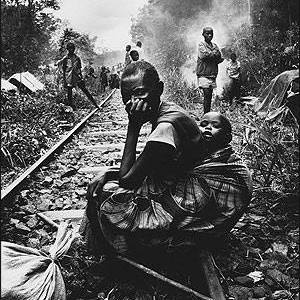Survivors of the massacres committed in Tingi-tingi camp and its surroundings, after crossing the Luluaba river at the level of the village of Ubundu, the Rwandan and Burundian Hutu refugees, for the most part, continued on their way and settled, around March 14, 1997, in a makeshift camp called “Camp de la Paix” [Peace Camp], located in the village of Obilo, 82 kilometres from Kisangani.
On March 20, 1997, AFDL / APR soldiers from Kisangani went to Obilo and ordered local authorities to bring all the refugees present in the village to the “Peace Camp” so that they can receive humanitarian aid.
At dawn on March 26, 1997, Rwandan RPA soldiers attacked the Peace Camp and killed hundreds of refugees, including women and children. Villagers heard gunfire for about 45 minutes that day. The next day they entered the camp strewn with casings and discovered the bodies of the victims. The Red Cross and some residents buried the bodies in four mass graves. Two of them are near the market, one near the church of Jehovah’s Witnesses and another on the banks of the Obilo River.
The refugees who left Obilo before the attack split in two directions. The first group left in the direction of Equateur province, cutting through the forest at kilometre point 52 and then passing through Opala territory.

A second group continued to advance towards Kisangani in the hope of gaining access to humanitarian aid, or even of being repatriated. Several tens of thousands of Hutus have settled in the village of Lula, 7 km from Kisangani, on the left bank of the river.
The refugees then improvised temporary camps along the railway line linking Kisangani and Ubundu over a distance of 125 kilometres, thus forming the camps of Kasese I and II
